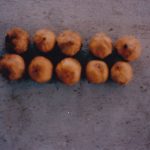Diospyros mespiliformis
Uses
Kenya (Mbeere division, Embu district): a gruel is made from the berry-like fruit. The fruit is reported sweet, and both pulp and seeds are edible. Sudan (Southern Kordofan): fruit eaten fresh, or dried and reconstituted in times of food shortage. Ethnomedical use: juice mixed with that of Balanites aegyptiaca (q.v.), for childhood colic and gastric troubles.
Additional Information
- Name Authority:
- Hochst, ex A. DC.
- Vernaculars:
- Kikuyu: mu -Koro. Arabic: Gughan
- Misc:
- Chemical composition (Sudan sample, after Abdelmuti): Protein (crude) = 3.0% (dry). Fat = 0.9% )(dry). Fibre (crude) = 16.5% (dry). Ash = 4.5% (dry). Carbohydrate (soluble): Starch = 6.1% (dry). Sucrose = 0% (dry). D-Glucose = 7.61% (dry). F-Fructose = 9.9% (dry). Amino acids (g [16g N]-1): Aspartic acid = 5.7g. Threonine = 3.0g. Serine = 3.3g. Glutamic acid = 6.6g. Proline = 7.6g. Glycine = 4.0g. Alanine = 3.3g. Valine = 4.3g. Cysteine = 1.0g. Methionine = 1.0g. Isoleucine = 3.7g. Leucine = 5.0g. Tyrosine = 2.0g. Phenylalanine = 3.3g. Lsyine = 4.0g. Histidine = 2.3g. Arginine = 4.0g. Minerals: Sulphur = 0.05% (dry). Phosphorus = 0.11% (dry). Magnesium = 0.08% (dry). Calcium = 0.37% (dry). Na = 0.01% (dry). K = 1.51% (dry). Zinc = 5mg/kg-1 (dry). Iron = 192mg/kg-1 (dry). Manganese = 5kg/kg-1 (dry). Copper = 1mg/kg-1 (dry).
